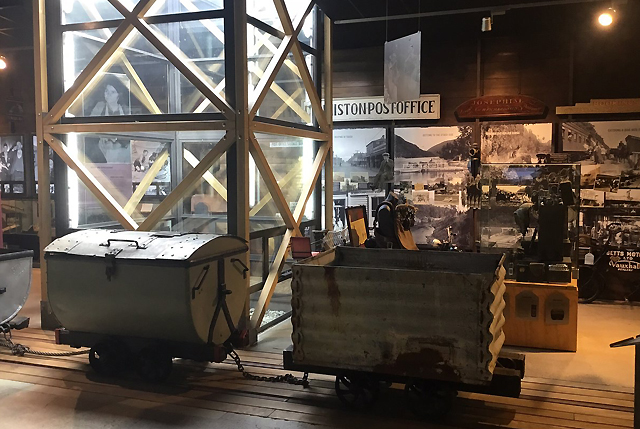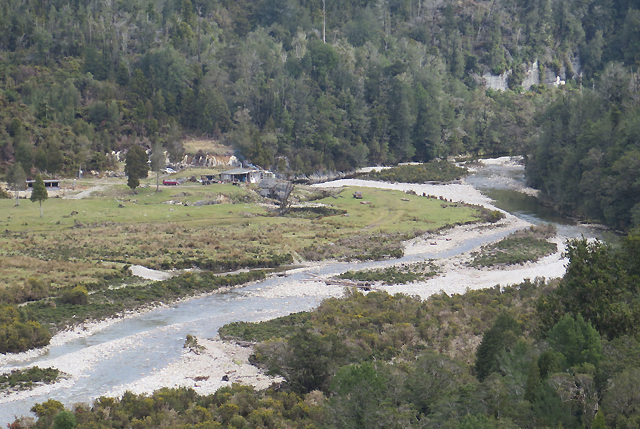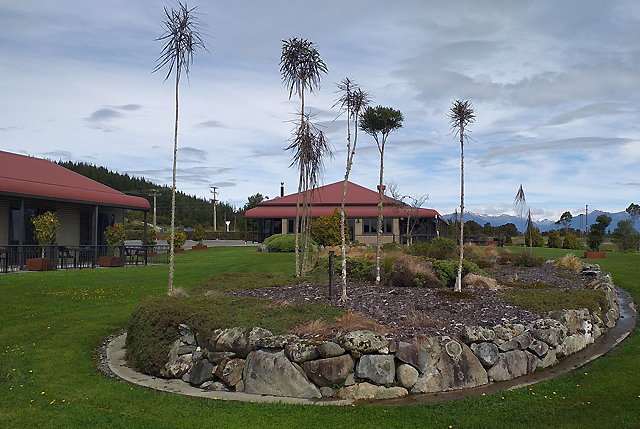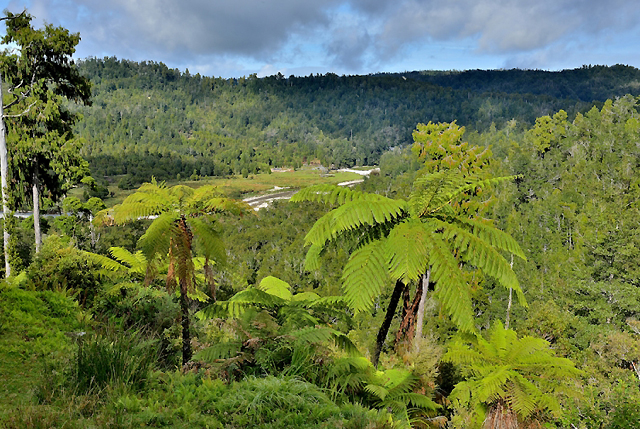They came for the gold but stayed for the coal. It’s a familiar refrain that echoed throughout my spring swing along the South Island’s West Coast. After shadowing the seductively foreboding forest-fringed curves of the pounamu-coloured Buller Gorge, Westport lays on a hearty welcome, where the iSITE also plays host to the highly engaging CoalTown Museum. If you’re keen to tap deep into the heart and soul of Buller, you won’t find a more impressive local tour operator than Out West Tours.

They run a variety of off road tours in superbly reconditioned Unimogs, to the likes of the Denniston Plateau, Warren Stratford’s astonishing John Deere Museum and deep into the heartland. Owned and operated by Mickey and Doreen Ryan, they’ve been sharing the riches of the Buller region with visitors for 19 years. Their passionate command of local history and the natural environment is vast, compellingly imparted with superb story-telling finesse. And those Unimogs boast the benefit of elevated seating, for superior wraparound views. Their newest offering is a 6 hour tour, called Johnny’s Journey, mixing an assortment of coastal gems with the wilderness.

Mickey Ryan is the quintessential nuggety Coaster, who regaled me with an unfurling spool of vivid stories and unvarnished insights, in disarmingly honest fashion. He’s tried his hand at a multitude of exploits, including successfully establishing the region’s first deep-sea fishing school. Heading out from Westport, we popped into Charleston, named after Charley Bonner, which during the 1860s gold rush, groaned with 80 hotels, quenching the thirst of the hordes of gold-diggers labouring along the Nile River. New Zealand’s first toll bridge was erected across the river by Constant Bay, just one gem in a necklace of stunning little bays off the tourist trail.

A paddle steamer formerly plied the river and Constant Bay was once used as a harbour, with ships squeezing through a narrow gap between the bay’s rocky headlands. Todd Heller has a gorgeous holiday home, overlooking Constant Bay. “There’s clearly money in sausages,” remarked Mickey. I marvelled over the quaint old harbour master’s house at Joyce Bay, and collected smooth quartz stones, like readymade jewellery, from the shoreline of Ladies Bay. Then we headed inland into Madmans Valley, where Mickey led me to the most dramatic limestone cliff gushing with a water spout, which has been nicknamed Cowpiddle Bluff. It’s very self-explanatory. Mickey recently built a magnificent flight of wooden steps to reach this striking formation.

Heading even deeper into the heartland, we forded some streams and headed over a saddle into the gob-smacking bucolic splendour of Awakari Valley, a sprawling rainforest valley neighbouring Paparoa National Park. The panoramic ridgeline lookout is mouth-watering, like casting your eyes over a frozen-in-time lost world. It’s the world’s biggest privately owned rimu forest, under the purview of a true living West Coast legend, Johnny Currie. He’s 79, as fit as a buck rat with the mind of a steel trap, and a bit like a cross between the Wizard of Christchurch and Barry Crump. He’s done it all.

Farming, logging, deerstalking, mining, caving and tour guiding. He’s the bushman’s bushman. And the 1800 hectares of this valley is his realm. An immense Garden of Eden, four and half times the size of Hagley Park. Previously owned by Hardie & Thomson, the Christchurch timber company, they sold it to Johnny in 1980, for $26,000. Johnny’s family connection with the Awakari Valley, reaches back more than a century to the settler years. As a child, Johnny would hunt wild goats with a dog and a flick knife. By the 1960s, he was leading bush gangs logging rimu. But since the 80s, Johnny has lived here, in a 50 year old bush hut not dissimilar to what his forebears sheltered in, when surveying the bush for its timber and minerals, a century ago. His son, Curtis, still lives in the valley in a separate hut. Some years ago DOC offered him over a million dollars for the valley, but he told him they were dreaming.

I chatted to Johnny alongside his cracking wood fireplace, about his poacher-turned-game-keeper conversion from clear-felling logger to forest protector, the surprises kept coming. I was taken on stroll through radiant green valley glades, to admire an ancient Maori cave bordering the river. The cave was used by moa hunters, centuries ago, where they set up camp for their food gathering. Moa bones were found in the area’s caves and given its deep history, Johnny gifted his cave to DOC, to safeguard it in perpetuity. But there was still one more huge revelation to come. Did you know that there are Pancake Rocks beyond the feted formations at Punakaiki? Johnny’s got a towering chain of Pancake Rock formations, rising up from the valley bed.

He’s cleaned a lot of them, so they shimmer like vast ivory-coloured stacks of limestone. The only way you can access the Awakari Valley, meet Johnny and marvel over his bewitching paradise is with Out West Tours. They are the sole operator and Mickey’s team are gearing up for their first summer sharing the Awakari with the world. It’s an irresistibly unique celebration of Kiwi heritage and culture, swathed in paradise. Sampling Johnny’s world is like savouring spectacular, larger-than-life version of Country Calendar in 3D. It’s an incomparable encounter. www.outwest.co.nz

Heading south along the Great Coast Road for Hokitika, four seasons in one day theatrically framed my journey, with forbidding storm clouds yielding to bright spring sunshine along the gloriously carved coastline, with Punakaiki soon shuffling into view. Just north of those striking rock formations, Truman Track is a banger of a bush walk, a short 30 minute return saunter to the ocean through untamed subtropical forest where podocarp and rātā trees tower above thickets of vine and nīkau palms. The track was extensively upgraded two years ago, with a climactic viewing platform elevated above the booming ocean, as waves smash onto the rock-strewn beach with unbridled fury.

This stretch of coastline boasts a riot of rock formations with precipitous cliffs, caverns, blowholes and a plummeting waterfall. Hello, sensory overload. It’s one of my favourite West Coast walks. The track is named in honour of Jim Truman who ran Truman’s Department Store in Greymouth. He had a bach opposite the original track which he substantially enhanced. The caves along the beach is where Bob Semple and Paddy Webb hid, as these conscientious objectors did not want to go to war.

Hokitika is such an ideal launch-pad for exploring the wider neighbourhood. Hokitika Gorge, Lake Mahinapua, Lake Kaniere, Dorothy Falls, the Treetop Walk and the goldrush powderkeg of Ross should all take high priority on your sightseeing check list.

I love the town’s Historic Empire Hotel. It was in Ross that the largest gold nugget in New Zealand was found in 1909. The “Honourable Roddy Nugget” was as big as a man’s fist and weighed 99 ounces. It was purchased by the NZ government and presented to King George V as a coronation gift.

A 1950 enquiry about the whereabouts of the nugget to the Royal Family resulted in the embarrassed Imperial Household reporting that the nugget had been melted down to gild a Royal tea service! Moreover, the tea service had gone awol. Gee, thanks. You can try your hand at gold-panning at Ross. The land beneath the township has never been mined and a crown geologist estimated in 1993 that gold deposits of about $700 million like beneath the town.

In the heart of Hokitika, the Heritage Walk is a waymarked trail threading together a highlights reel of sites that speak to the town’s extraordinary past. I particularly love the Gibson Quay stretch of the walk, not just for the splendid panorama across the Hokitika River to the Southern Alps, but also for the interpretation panels and goldrush-era buildings that stand like totems to Hokitika’s boomtime as a port town. In 1866, it was one of the most populous settlements in New Zealand with more than 25,000 residents, lubricated by more than 100 pubs. By 1867, Hokitika was the nation’s most valuable port for export goods and shipping traffic. There’s some staggering photos of over 40 vessels tied up at the wharf, while over 210 ships sailed direct from Australia that year.

I also ventured onto Blue Spur, which backs Hokitika, tumbling down from the Southern Alps. This was a major goldfield back in the day, with old Chinese goldmining workings ever-present in the regenerating native forest. It’s also where I stayed the night at the exceptionally inviting Station’s Inn. Despite being less than five minutes from town, you’ll relish the sense of escapism here, into forest-wrapped farmland.

Perched on an elevated terrace amid pristine countryside and impeccably manicured lawns, Stations Inn offers 4-star plus luxury accommodation and an award-winning restaurant, that’s currently operating on the weekend. Stations Inn was re-born 16 years ago by Hugh and Glenda Little on an historic site in the Blue Spur goldfields. The original Station Hotel was a licensed establishment in 1867, taking its name from being the station at the end of the horse drawn tram track.

You’ll enjoy drool-worthy sunsets from the comfort of your luxurious executive studio or premiere king suite accommodation, when you’re not feeding the friendly alpacas. There’s plenty of vestiges and nods to the past, from the working waterwheel to the historic fixtures in the bar. It’s an indelible fusion of contemporary comfort with heritage glory. You’ll love it. www.stationsinnhokitika.co.nz

For more regional touring tips in this sublime pocket of New Zealand, head to www.westcoast.co.nz













Recent Comments